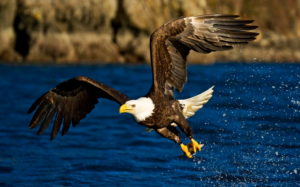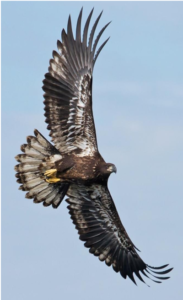
- Appearance:white head and tail, brown body, broad wings, yellow eyes, beak, and feet
- United States national bird since 1782 (American Revolution ended 1783), spiritual symbol for Native Americans much longer
- “Bald” comes from outdated saying “piebald,” meaning white markings on otherwise dark body
- Males and females have similar plumage coloration, but female is larger
- Length:28-38 inches (about 2-3 feet)
- Wingspan: 80 inches (about 7 feet)
- Status:common, returning to pre-endangerment ranges that still have favorable habitat
- Almost driven to extinction mid-late 1900s due to hunting as well as DDT-caused reproductive failure and pesticide poisoning
- Still vulnerable to habitat loss and poaching, as their feathers are extremely valuable in Native American black markets for religious rituals
- Habitat
- Forested areas near large lakes or estuaries
- Stay away from heavily developed/industrial areas
- Found throughout North America
- Diet
- Preferred diet is fish, but will adapt diets to whatever prey is available in range
- Marine invertebrates, birds, reptiles, amphibians, and small mammals
- Eat prey live, freshly killed, or already dead (carrion)
- Commonly harass other eagles, ospreys, even vultures to steal food
- When hunting, perch high in trees and watch for prey
- Fly above prey nearly horizontally and grab with talons, can pluck fish from surface of water – carries prey up to 50% body weight
- Preferred diet is fish, but will adapt diets to whatever prey is available in range
- Migration
- Bald eagles that breed in mainland Alaska or Canada are migratory
- Spring migration occurs January-March, adults arrive before immatures
- Fall migration occurs once lakes begin to freeze over, juveniles leave before adults, usually leave 6-8 weeks after fledging
- Migratory bald eagles overwinter over much of United States, as long as they can find a large body of water unoccupied by other bald eagles
- In temperate or coastal regions, bald eagles are nonmigratory
- Ride on rising currents of warm air called “thermals” – soar to conserve energy
- Fly at heights of up to 10,000 feet
- Travel average of 100 miles/day, but can travel up to 225 miles in a day
- Top speed level flight is about 30 mph, with tailwind can reach 50mph, dives can reach 100 mph
- Bald eagles that breed in mainland Alaska or Canada are migratory
- Nesting
- Nest high in trees in forest canopy 50-120 feet off ground, nests called “aeries”

- Build one of largest nests of all birds: 4-6 foot diameter and 2-4 foot height
- Mate for life, rarely male may mate with two females
- Return to same nesting site each year, can add 1-2 feet new material to existing nest
- Highly territorial, will attack any intruder
- Average brood is 1-3 white eggs
- Parents take turns hunting and watching over hatchlings
- Fledglings learn to fly at 10-12 weeks, parents often encourage them
- Juvenile eagles (“eaglets”) brown with patterns of white feathers across body, wings, and tail
- Sometimes seen playing with sticks, rocks, even plastic bottles to hone hunting skills
- Start breeding at 5 years old
- Bald eagles live about 15-20 years in wild, oldest wild bald eagle was 38, oldest in captivity was nearly 50
- Nest high in trees in forest canopy 50-120 feet off ground, nests called “aeries”






